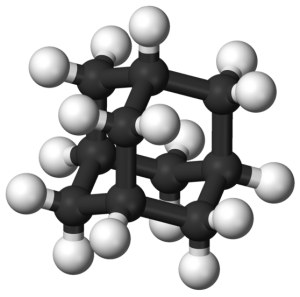 Adamantane, the invincible molecule, was discovered in petroleum in 1933 and stimulated a whole new field in chemistry, that of research into polyhedral organic compounds. It might be thought of as the tiniest possible building block of diamond, which is after all an infinite 3D network of carbon atoms essentially pinned on the adamantane structure minus the hydrogens. Adamantane itself has been modified for practical applications in the pharmaceutical industry, in polymer science for heat-stable lubricants and others uses, and as molecular building blocks in nanotechnology. But, this “diamondoid” and its chemical cousins might also be the molecular mavens we need to guide hydrocarbon exploration.
Adamantane, the invincible molecule, was discovered in petroleum in 1933 and stimulated a whole new field in chemistry, that of research into polyhedral organic compounds. It might be thought of as the tiniest possible building block of diamond, which is after all an infinite 3D network of carbon atoms essentially pinned on the adamantane structure minus the hydrogens. Adamantane itself has been modified for practical applications in the pharmaceutical industry, in polymer science for heat-stable lubricants and others uses, and as molecular building blocks in nanotechnology. But, this “diamondoid” and its chemical cousins might also be the molecular mavens we need to guide hydrocarbon exploration.
Underground fossil fuel reservoirs including natural gas, gas condensate, petroleum and coal are the natural resources of hydrocarbons we rely on the most and commonly contain diamondoid hydrocarbons, says Patricia Lopes Barros de Araujo of the Federal Rural University of Pernambuco in Brazil, Ali Mansoori of the University of Illinois, USA and Elmo Silvano de Araujo of the Federal University of Pernambuco also in Brazil, who have reviewed the state of the art recently in the journal IJOGCT (full reference below).
Fundamentally, the team explains, diamondoids can act as geochemical tools for petroleum characterisation, their presence on fossil fuel fluids also gives researchers a way to evaluate petroleum sample quality, to determine its origin, investigate the degree of biodegradation and thermal maturity and event to help find and assess new sources of petroleum. “The presence of diamondoids in petroleum has become much more than a chemical curiosity,” they explain.
![]() Patricia Lopes Barros de Araujo, Elmo Silvano de Araujo, & Ali Mansoori (2012). Diamondoids: occurrence in fossil fuels, applications in petroleum exploration and fouling in petroleum production. A review paper Int. J. Oil, Gas and Coal Technology, 5 (4), 316-367
Patricia Lopes Barros de Araujo, Elmo Silvano de Araujo, & Ali Mansoori (2012). Diamondoids: occurrence in fossil fuels, applications in petroleum exploration and fouling in petroleum production. A review paper Int. J. Oil, Gas and Coal Technology, 5 (4), 316-367